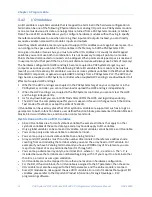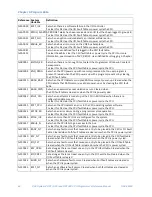
Chapter 3. Program Data
GFK-2950C
February 2018
33
I/O Variable Format
To map an I/O variable, use the format
%vdr.s.
[
z.
]
g.t
:
v
= I (input) or Q (output)
d
= data type: X (discrete) or W (analog).
r
= rack number
s
= slot number
[
z
] = sub-slot number. This element and the period that follows it appear only if there is a sub-slot,
for example, the SBA number of a Genius device. For an Ethernet daughterboard, set this value to 0.
g
= segment number or number of the reference address node. Set to 0 for the first reference
address node on the Terminals tab, 1 for the second reference node, and so on.
t
= terminal number. One-based, that is, the numbering begins at 1.
Supported I/O Variable Types
Data Type Mnemonic
Supported Data
Types
Number of Consecutive Terminals
Required
X
BOOL variable
1
BOOL array
Number of elements in array.
BYTE variable
8
BYTE array
8n, where n is the number of array elements.
W
DINT variable
2
DINT array
Number of elements in array times 2
DWORD variable
2
DWORD array
Number of elements in array times 2
INT variable
1
INT array
Number of elements in array
LREAL variable
4
LREAL array
Number of elements in array times 4
REAL variable
2
REAL array
Number of elements in array times 2
UINT variable
1
UINT array
Number of elements in array
WORD variable
1
WORD array
Number of elements in array
I/O Variable Examples
The I/O variable, Sample_IO_Variable is mapped to a non-discrete (W) output point (Q) on the
module located in rack 0, slot 8. The variable is mapped to the first point in the first group of non-
discrete output reference addresses.
The I/O variable, IO_VAR_EXAMPLE, is mapped to a discrete (X) input point (I) on the module located
in rack 0, slot 5. The point is located in the module’s third group of discrete input points and is point 2
in that group.
Summary of Contents for PACSystems RSTi-EP
Page 357: ......
Page 466: ...Chapter 9 Diagnostics GFK 2950C February 2018 451 ...
















































